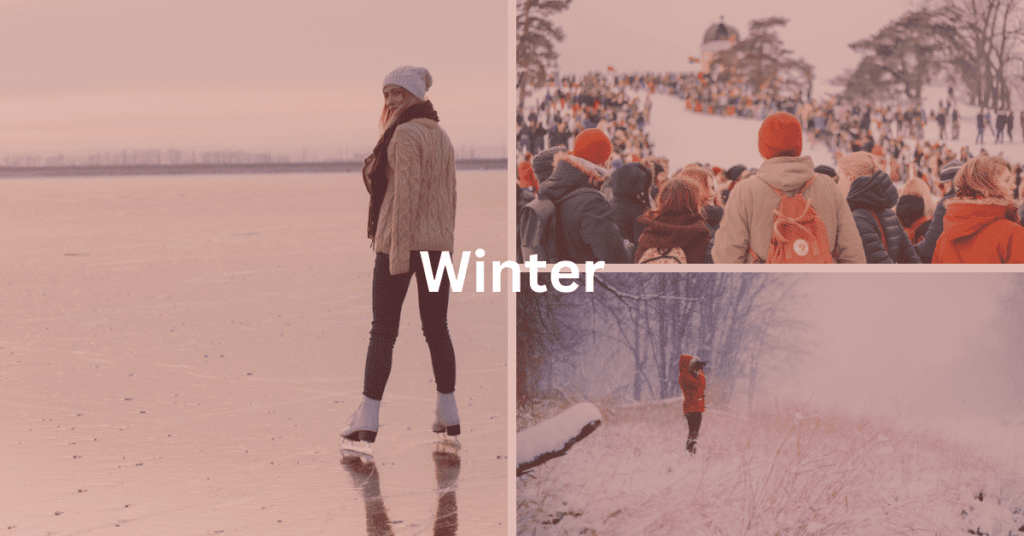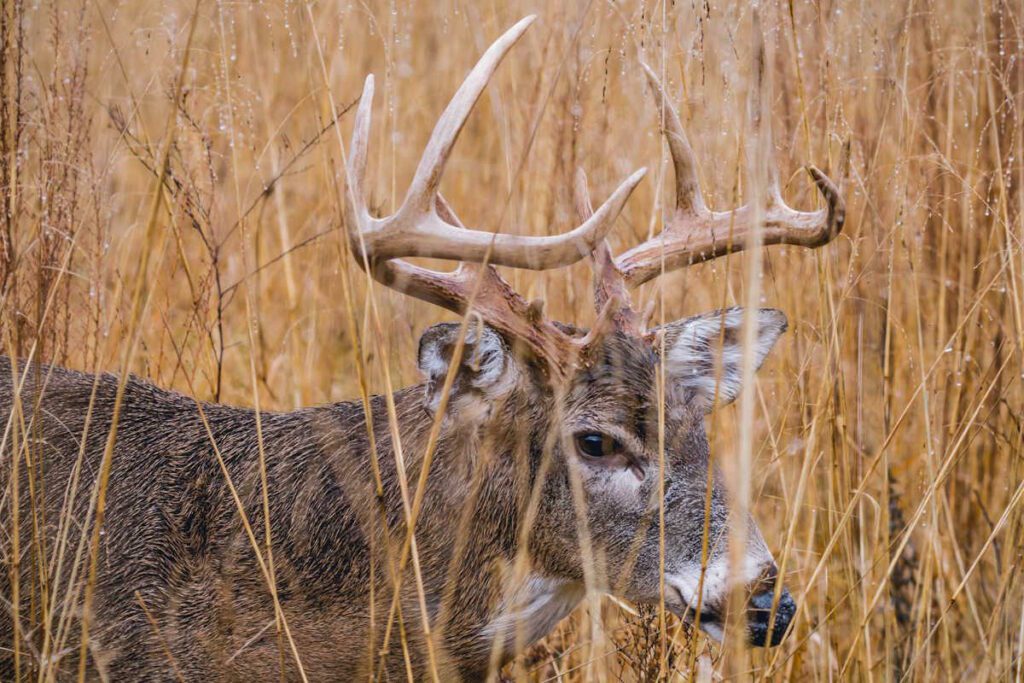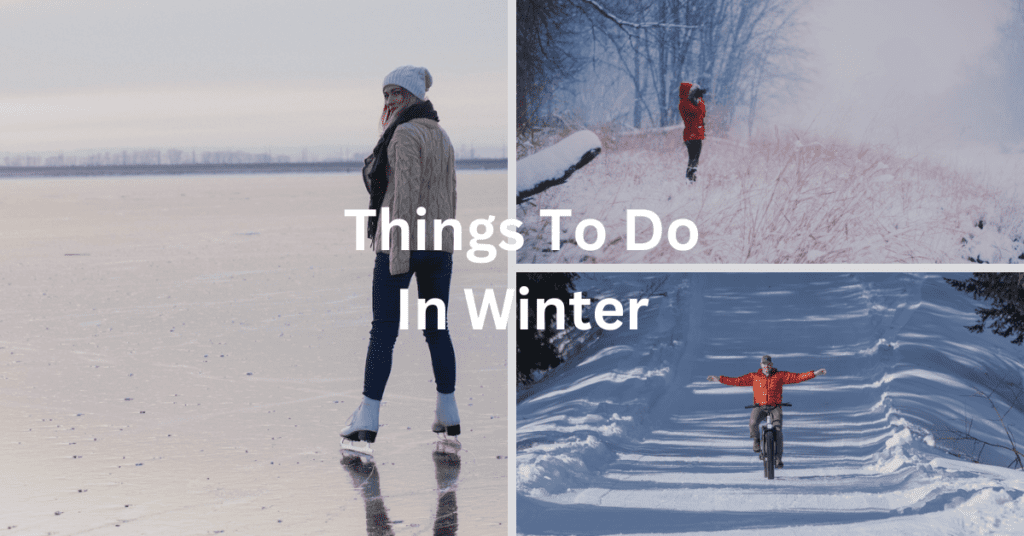Winter in Door County is less popular as a tourist season, but personally, I love this time of year. As the seasons change and temperatures drop, this picturesque Wisconsin peninsula transforms into a serene winter wonderland. It’s worth visiting Door County in the Winter. As a Door County local, I can help you learn more about this amazing place in a time when most people neglect it.

Door County Winter Lodging
Are you looking for a hotel in Door County for a winter trip? Check out our post on Door County’s best hotels to find a great hotel for your winter trip.
Posts about Winter in Door County
Door County Winter Festivals & Events
30 Best Things To Do in Winter in Door County
Winter Climate in Door County
Winter in Door County brings a mix of chilly temperatures and picturesque snowfall. Let’s take a closer look at the climate month by month:
December:
- In December, Door County experiences the onset of winter with average temperatures ranging from 25°F to 34°F (-4°C to 1°C).
- Snowfall is common, and you can expect around 10 inches of snow during this month.
- It’s a great time for cozying up by the fireplace and enjoying the festive holiday decorations.
January:
- January is the coldest month, with temperatures averaging between 19°F and 29°F (-7°C to -2°C).
- Snowfall increases, reaching an average of 11 inches, creating a winter wonderland.
- Outdoor activities like cross-country skiing and ice fishing are popular among locals and visitors.
February:
- Although still cold, February begins to show signs of the approaching spring. Average temperatures range from 21°F to 32°F (-6°C to 0°C).
- Snowfall remains consistent at around 9 inches, making it an ideal time for winter sports enthusiasts.
- The quieter ambiance in Door County during this time allows for peaceful exploration of its scenic beauty.
While winter in Door County can be brisk, the serene landscapes and unique experiences it offers make it a memorable destination for those seeking a peaceful winter escape.
Winter Wildlife in Door County

During the serene winter months in Door County, the local wildlife gracefully adapts to the cold, creating unique opportunities for observation.
White-tailed Deer
Among the most common winter wildlife sightings are white-tailed deer, which thrive despite the chilly temperatures. Their brown coats stand out vividly against the snowy backdrop as they forage for food in wooded areas or even venture into residential areas in search of sustenance.
Bald Eagles
Door County is also renowned for its bald eagle population, and the winter season provides an excellent chance for birdwatchers to spot these majestic birds. As the waters freeze over, bald eagles often perch along the shores, ready to swoop down for a catch from the icy waters.
Snowy Owls
A particularly enchanting winter visitor is the snowy owl. These Arctic owls with their striking white plumage become part of the winter landscape, attracting bird enthusiasts to the area in hopes of a rare sighting.
Coyotes and Foxes
Coyotes and foxes are known to leave their tracks in the snow as they roam the wintry woods, adding to the rich tapestry of wildlife in this serene winter wonderland. Exploring Door County’s winter wildlife is an adventure that adds depth and fascination to your visit, and it’s an excellent opportunity to observe nature’s resilience in the face of winter’s challenges. Don’t forget to bring your binoculars and camera to capture these magnificent creatures in their natural habitat.
Popular Winter Activities in Door County

When the snow blankets Door County, it transforms into a playground for winter enthusiasts, offering a wide array of activities to keep you entertained throughout the season.
Ice Fishing
One of the quintessential winter pastimes in Door County is ice fishing. As the lakes freeze over, ice anglers eagerly set up their shanties, drilling holes in the ice to catch perch, walleye, and other local fish species. It’s not just about the catch; it’s about the camaraderie and the thrill of reeling in a fish through the ice.
Snowshoeing and Cross-Country Skiing
The county’s extensive network of trails becomes a winter wonderland for snowshoers and cross-country skiers. Whether you’re a beginner or an experienced enthusiast, the tranquil forests and scenic routes provide an excellent backdrop for these activities. Rentals are readily available for those looking to try them out.
Hunting
For those interested in hunting, Door County offers opportunities for deer hunting during the winter months. The sport is regulated, and hunters must adhere to strict guidelines, but it’s a popular activity for many locals and visitors.
Snowmobiling
Snowmobiling enthusiasts will find miles of well-groomed trails crisscrossing the county. These trails take you through forests, along frozen lakeshores, and into charming towns, making it a thrilling way to explore the winter landscape.
Sledding
If you’re traveling with family, sledding is a must-do activity. There are designated hills and slopes where you can sled to your heart’s content, creating cherished memories with loved ones.
Door County’s diverse range of winter activities ensures that there’s something for everyone to enjoy during the winter months. Whether you’re seeking adventure or tranquility, you’ll find it amid the county’s snowy landscapes and welcoming communities. So, bundle up and embrace the winter spirit in Door County.
Why People Enjoy Visiting Door County in the Winter
Winter in Door County holds a special charm that captivates the hearts of visitors and locals alike. Here are some compelling reasons why people relish a winter getaway to this enchanting Wisconsin destination:
Serene Scenery
The transformation of Door County into a winter wonderland is truly magical. Snow blankets the landscapes, glistening under the soft winter sun. The sight of snow-covered trees and frozen lakes creates a serene and picturesque backdrop that’s perfect for relaxation and photography.
Outdoor Adventures
Winter brings a host of exciting outdoor activities. From ice fishing on frozen lakes to cross-country skiing and snowshoeing along scenic trails, there’s no shortage of adventure for outdoor enthusiasts. The crisp, clean air and the crunch of snow underfoot provide a refreshing experience.
Cozy Accommodations
Door County’s charming inns, cabins, and bed-and-breakfasts take on a warm and inviting atmosphere during the winter months. Cozy up by a crackling fireplace, sip hot cocoa, and unwind in a snug and tranquil environment.
Peaceful Escape
Winter in Door County offers a peaceful escape from the hustle and bustle of everyday life. With fewer crowds, you can explore the area’s natural beauty at your own pace. The quietude of winter creates a tranquil ambiance that’s ideal for reflection and relaxation.
Culinary Delights
The county’s restaurants and cafes continue to serve up delicious cuisine during the winter. Savor hearty comfort food, sip on local wines, and enjoy the flavors of Door County in a cozy setting.
Holiday Festivities
If you visit in December, you’ll be treated to festive holiday celebrations. Door County’s communities come alive with holiday lights, parades, and special events, creating a joyful atmosphere that’s perfect for families and couples.
Friendly Locals
Door County residents are known for their warmth and hospitality. During the winter months, when the pace of life slows down, you’ll find that locals are even more welcoming, eager to share their love for the area and its winter charm.
Visiting Door County in the winter offers a chance to experience a different side of this enchanting destination. Whether you’re seeking outdoor adventures, a tranquil escape, or simply the joy of witnessing the beauty of winter, Door County has something to offer every winter traveler. So, don your winter gear and embark on a memorable winter journey to this hidden gem in Wisconsin.
The Etymology of the Word “Winter”
The word “winter” has its roots in Old English and can be traced back through the history of the English language to reveal its fascinating etymology.
In Old English, the term “winter” was spelled as “wintru,” and its origins can be found in the Proto-Germanic word “wintruz.” This Proto-Germanic word likely derived from an even more ancient Proto-Indo-European root, “wend,” meaning “water” or “wet.” This association with moisture and wetness probably arises from the fact that, in many regions, winter is a season characterized by cold temperatures and increased precipitation in the form of snow and rain.
Over time, the word evolved in Middle English to “wynter” before settling into its modern spelling and pronunciation as “winter.” The meanings associated with “winter” have also expanded beyond just the season itself. It can evoke feelings of coldness, dormancy, and the end of the year. Additionally, “winter” has been used metaphorically in literature to represent difficult or challenging periods in one’s life.
The etymology of “winter” serves as a reminder of the historical and cultural significance of this season in human language and experience. It reflects our enduring fascination with the changing seasons, the cycles of nature, and the poetic symbolism we attach to them. Whether we celebrate the winter holidays, engage in winter sports, or simply enjoy the beauty of snow-covered landscapes, the word “winter” encapsulates a rich history and a range of emotions associated with this time of year.
Why the Weather Changes in Winter
The changing weather patterns in winter are a result of the Earth’s axial tilt and its orbit around the sun. Here’s why the weather undergoes significant changes during this season:
Earth’s Axial Tilt
The primary reason for seasonal changes, including winter, is the tilt of Earth’s axis. The Earth’s axis is tilted approximately 23.5 degrees relative to its orbit around the sun. This tilt causes different parts of the Earth to receive varying amounts of sunlight at different times of the year.
Winter Solstice
Around December 21st or 22nd in the Northern Hemisphere, the North Pole is tilted farthest away from the sun, marking the winter solstice. This results in shorter daylight hours and the sun appearing lower in the sky, causing a decrease in temperatures.
Angle of Sunlight
During the winter months, the angle at which sunlight strikes the Earth’s surface is shallower, leading to less direct heating. Sunlight is spread over a larger area, which means less heat is generated.
Polar Air Masses
As the northern regions cool down due to reduced sunlight, polar air masses develop. These cold, dense air masses bring frigid temperatures and can extend their influence into mid-latitudes.
Polar Jet Stream
The polar jet stream, a high-speed ribbon of air in the upper atmosphere, tends to dip southward during winter in the Northern Hemisphere. This movement can influence weather systems and bring colder air masses southward, resulting in winter storms.
Snow and Albedo
As winter progresses, the accumulation of snow cover can further reduce temperatures. Snow has a high albedo, meaning it reflects a significant portion of incoming sunlight, preventing the ground from absorbing heat.
In summary, the changing weather in winter is primarily driven by the tilt of Earth’s axis and its orbit around the sun. This astronomical phenomenon leads to reduced sunlight, lower solar angles, the development of polar air masses, and the southward movement of the polar jet stream. Combined, these factors result in the colder temperatures, shorter days, and distinctive weather patterns that define the winter season.
Winter in Popular Culture
Winter has long been a source of inspiration in popular culture, influencing music, art, performances, and various forms of media. Here’s a glimpse into how winter is celebrated and depicted in the world of entertainment and art:
Music
- “Winter Wonderland”: This timeless holiday song, written in 1934, celebrates the joy of winter and snowfall. It has been covered by countless artists and is a staple of holiday playlists.
- Tchaikovsky’s “The Nutcracker”: This iconic ballet, set during a snowy Christmas Eve, has become synonymous with the holiday season. The “Dance of the Sugar Plum Fairy” and “Waltz of the Snowflakes” evoke the magic of winter.
Art
- Winter Landscapes: Throughout art history, painters have captured the beauty of winter landscapes. Artists like Pieter Bruegel the Elder and Claude Monet have created stunning winter scenes that convey the serenity and purity of the season.
- Seasonal Cards: Winter-themed greeting cards and illustrations often feature snowy scenes, cozy firesides, and festive decorations. These images evoke a sense of nostalgia and warmth.
Performances
- Holiday Theater Productions: Many theaters stage adaptations of classic holiday tales during the winter season. Productions of “A Christmas Carol” and “The Grinch Who Stole Christmas” are beloved traditions.
- Ice Skating Shows: Ice skating performances and figure skating competitions, often set to winter-themed music, capture the grace and beauty of the season.
Television
- Winter Episodes: TV shows often dedicate special episodes to winter themes. From holiday-themed sitcom episodes to animated specials like “Rudolph the Red-Nosed Reindeer,” these programs bring the spirit of winter to the small screen.
- Winter Sports Coverage: Winter sports, including the Winter Olympics, are a prominent part of television programming during the season, showcasing the athleticism and drama of cold-weather sports.
Literature
- Classic Novels: Many classic novels are set in winter or use it as a thematic backdrop. “Winter’s Tale” by Mark Helprin and “The Lion, the Witch and the Wardrobe” by C.S. Lewis are examples of works that transport readers to wintry worlds.
- Winter Poetry: Poets like Robert Frost have penned verses that capture the essence of winter, with themes of solitude, beauty, and reflection.
Film
- Holiday Movies: Winter is the backdrop for countless holiday films, from heartwarming classics like “It’s a Wonderful Life” to family favorites like “Home Alone.”
- Snowy Adventures: Adventure films often incorporate winter settings to add drama and excitement. Movies like “The Revenant” and “The Empire Strikes Back” feature memorable winter scenes.
In popular culture, winter serves as a canvas for creativity, evoking a range of emotions from nostalgia and joy to solitude and introspection. Whether it’s through festive songs, snowy landscapes in art, or heartwarming holiday films, winter’s influence continues to shape our cultural experiences and celebrations throughout the season.
Winter and Human Psychology
Winter’s arrival can have a profound impact on human psychology, influencing emotions, behaviors, and overall mental well-being. Here’s a look at how this season affects us psychologically:
Seasonal Affective Disorder (SAD)
Winter is often associated with an increased prevalence of Seasonal Affective Disorder, or SAD. This mood disorder is characterized by recurrent depressive episodes that occur during the fall and winter months, when sunlight exposure is reduced. Symptoms include sadness, fatigue, irritability, and changes in sleep patterns and appetite. Light therapy, outdoor activities, and social engagement are commonly recommended treatments for SAD.
Reduced Sunlight
The decrease in daylight hours during winter can disrupt our circadian rhythms, leading to feelings of lethargy and fatigue. The limited exposure to natural light can also affect the production of serotonin, a neurotransmitter linked to mood regulation. This may contribute to feelings of sadness or depression for some individuals.
Cabin Fever
Staying indoors for extended periods due to harsh weather conditions can lead to a phenomenon known as “cabin fever.” This feeling of restlessness, boredom, or irritability can result from being cooped up indoors for too long. Engaging in indoor hobbies, exercise, or social activities can help alleviate these symptoms.
Hygge and Comfort
Many people find comfort in the Danish concept of “hygge” during winter. Hygge emphasizes coziness, warmth, and togetherness, which can have a positive impact on mental well-being. Creating a cozy and inviting atmosphere at home with blankets, candles, and warm beverages can enhance feelings of contentment and relaxation.
Seasonal Activities
Embracing winter activities like skiing, ice skating, or building snowmen can boost mood and promote a sense of accomplishment. Engaging in enjoyable seasonal hobbies provides a sense of purpose and helps combat winter blues.
Reflection and Introspection
The quieter, more introspective nature of winter can encourage self-reflection and contemplation. It’s a time when people often set goals, make resolutions, and plan for the future.
Community and Togetherness
The winter season is marked by various holidays and celebrations that bring people together. These social connections and gatherings can provide emotional support and a sense of belonging, which is vital for mental well-being.
Resilience and Adaptation
For some, the challenges of winter can foster resilience and adaptability. Facing adverse weather conditions and overcoming winter-related obstacles can build confidence and a sense of accomplishment.
In conclusion, winter’s impact on human psychology is multifaceted. While it can bring about challenges such as SAD and cabin fever, it also offers opportunities for reflection, togetherness, and personal growth. Understanding these psychological dynamics and adopting strategies to maintain mental well-being during the winter months can help individuals navigate the season with greater ease and positivity.
Summary: Winter in Door County
- Door County experiences average temperatures ranging from 19°F to 34°F during winter, with January being the coldest month.
- Winter in Door County offers wildlife sightings, including white-tailed deer and bald eagles.
- Popular winter activities in Door County include ice fishing, snowshoeing, and cross-country skiing.
- The word “winter” originates from Old English “wintru” and has ties to Proto-Germanic “wintruz.”
- Winter changes result from Earth’s axial tilt, leading to reduced sunlight and polar air masses.
- Winter in popular culture is celebrated through music (“Winter Wonderland”), art (winter landscapes), and films (holiday classics).
- Winter can affect human psychology, with Seasonal Affective Disorder (SAD) being a common concern.
- Reduced sunlight in winter can disrupt circadian rhythms and serotonin production, affecting mood.
- “Hygge,” a Danish concept of coziness, can improve mental well-being during winter.
- Winter fosters reflection and introspection, and community gatherings provide emotional support.
- The challenges of winter can build resilience and adaptability in individuals.

